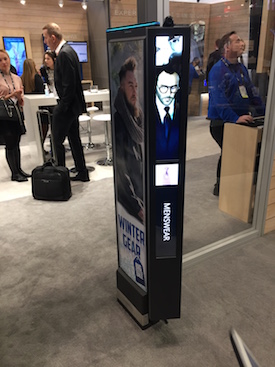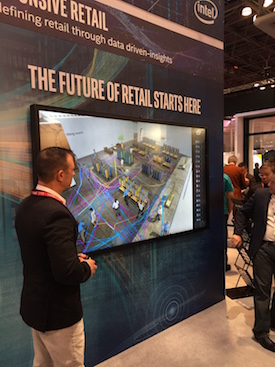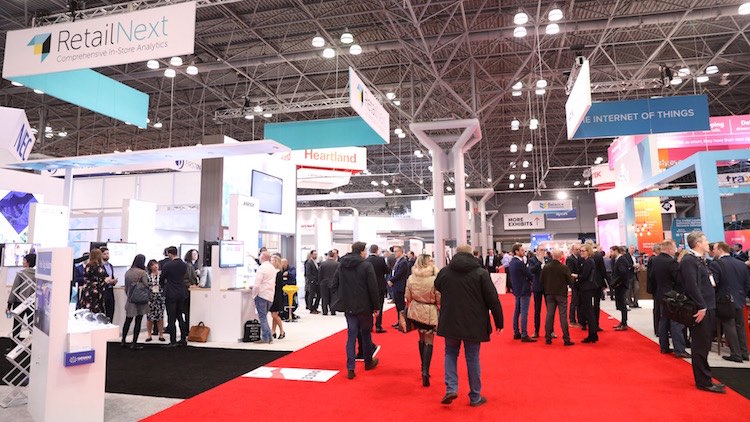- The 2018 National Retail Federation show at the Javits Center in New York offered attendees fascinating insight into what shopping could look like in the next few years. With tech companies from Intel to Epson showcasing solutions, it also highlighted plenty of new opportunities for AV integrators to help bring about this future.
- 1. No More Price Tags
AWM's Smart Shelf The days of printed price labels for merchandise seem numbered. All around the show floor were digital alternatives: a host of companies, such as SES-imagotag, Display Data, Pricer, and SoluM, were demonstrating electrophoretic display-based solutions. With “e-ink” displays, similar to those on e-reader tablets, these simple labels connect via Wi-Fi to price management software for fully automated price updating—saving employees from having to walk around a store and change prices by hand.
On the more sophisticated end were solutions that turn the entire shelf end into a display. Grocery store giant Kroger showed its own solution, called Edge, in the Microsoft booth. Using short-throw rear projection mounted under the shelf, the shelf’s edge can display pricing, promotional information, and even videos, using the Microsoft Azure platform. Currently in 17 stores with plans to expand to 120 in the next year, the system also has the capability to interact with shoppers’ smartphones via an app, and perform functions like help direct customers to the items on their shopping lists.
Another similar solution, by AWM, was on display in the Intel booth. Using direct-view LED displays, the company’s Smart Shelf product can show pricing and promotional content, but also integrates front and rear-facing cameras. The wide-angle, low-light, rear-facing cameras track inventory; according to co-founder and COO Kurtis Van Horn, the Smart Shelf’s insight has made Pepsi 25 to 30 percent more efficient in its restocking operations (AWM has partnered with companies like Pepsi and Hershey’s, and its products are currently in use in five Walmart stores at those brands’ displays). The Smart Shelf’s front-facing cameras employ facial recognition technology to tailor what’s being displayed to the person looking at it. For example, in areas with large Spanish-speaking demographics, the Smart Shelf can change its language to Spanish when a Hispanic person approaches.
2. Personalized Shopping
Like the AWM solution, many companies were showing systems that employ cameras to identify who is shopping, as well as to provide a fun, interactive experience. At its booth, NEC demonstrated an “immersive retail experience” that begins with cameras using its facial recognition technology. When customers walk into a store, the camera quickly identifies them by their face, and displays a welcome message on a screen—with other information like how many loyalty points they have to spend. Then, with object recognition technology, the store is aware of what items the customers have picked up, and since the shoppers have already been identified by their face, the store can simply charge their account for the items they took—no checkout required.

Tyco's concept solution displays promotions to people based on their demographic as they enter a store Tyco was showing a concept solution that affixes a narrow video screen to the edge of security scanner gates that flank store entrances. Using a camera with facial recognition, they can display offers specific to the demographic of the person entering the store—for example, men’s suits for an 18-35 year old male customer.
Several companies were demonstrating interactive “mirror” kiosks, with a particular emphasis on high-end fashion shopping. Elo demonstrated two products developed with MemoMi that utilize cameras to give customers a fun way of seeing how they look in different clothing. The solutions are currently installed in 70 to 80 stores worldwide, including luxury retailer Neiman Marcus. In those stores, women can try on a dress, then, standing in front of the kiosk, easily see how they look from all angles, virtually change the color of the dress, and send a picture or video of themselves to their phone, so they can share with friends for a second opinion.
Elo also showcased an on-wall touchscreen concept with partner Nanonation that helps shoppers pick an outfit by asking them to select various preferences on things like food and interior decorating style, then suggests a personalized look tailored to those choices.
3. AR, VR, and MR are Coming
About as hot of a topic there is in tech, augmented, virtual, and mixed reality technologies are showing real promise for practical use in retail. Mastercard, through a partnership with AVA Retail, demonstrated a checkout-free, “frictionless retail” experience similar to NEC’s, also highlighted some AR and VR shopping applications. In one, developed for Swarovski, users download an app to their smartphone, and using a VR headset, can browse through a virtual home replete with the company’s Atelier Swarovski home décor line and make purchases using Masterpass.
At its booth, Verizon highlighted its partnership with AR/VR designer Envrmnt. Using an app for iOS and Android, customers point their smartphone at a target image—like a product on a shelf—to trigger onscreen overlays that can provide more information about the product, or even animations relating to the product. An example case offered was for a children’s play set: shoppers can point their phone at the product’s box, triggering a three-dimensional rendering of the fully assembled product to appear onscreen.
4. Data Harnessing
Intel presented on the ways it's using data to help retailers run more efficiently While integrating all of the aforementioned technologies makes for an enhanced shopping experience for consumers, the stores are the ones that gain the most. That is, of course, because all of the cameras and sensors utilized in those solutions generate rich data that enterprises can harness to increase their efficiency. Almost every company at the show had some pitch about using data to generate actionable insight—knowing the age, gender, and ethnicity of their customers, what products they’re interested in, dwell times, and more—to better tailor their offerings. Much like online ads that show offers for products you’ve searched for, stores will know what you want when you visit them, based on things you’ve picked up and looked at, or how much time you’ve stood in front of a certain shelf.
In addition to products like AWM’s Smart Shelf, several companies demonstrated aisle-roaming, shelf-scanning robots that keep retailers constantly appraised of inventory levels, ensuring that popular items always remain in stock. With all of this data and insight all the way up the supply chain, retailers and the companies that supply them will be able to operate at levels of efficiency unfathomable just a few years ago.

